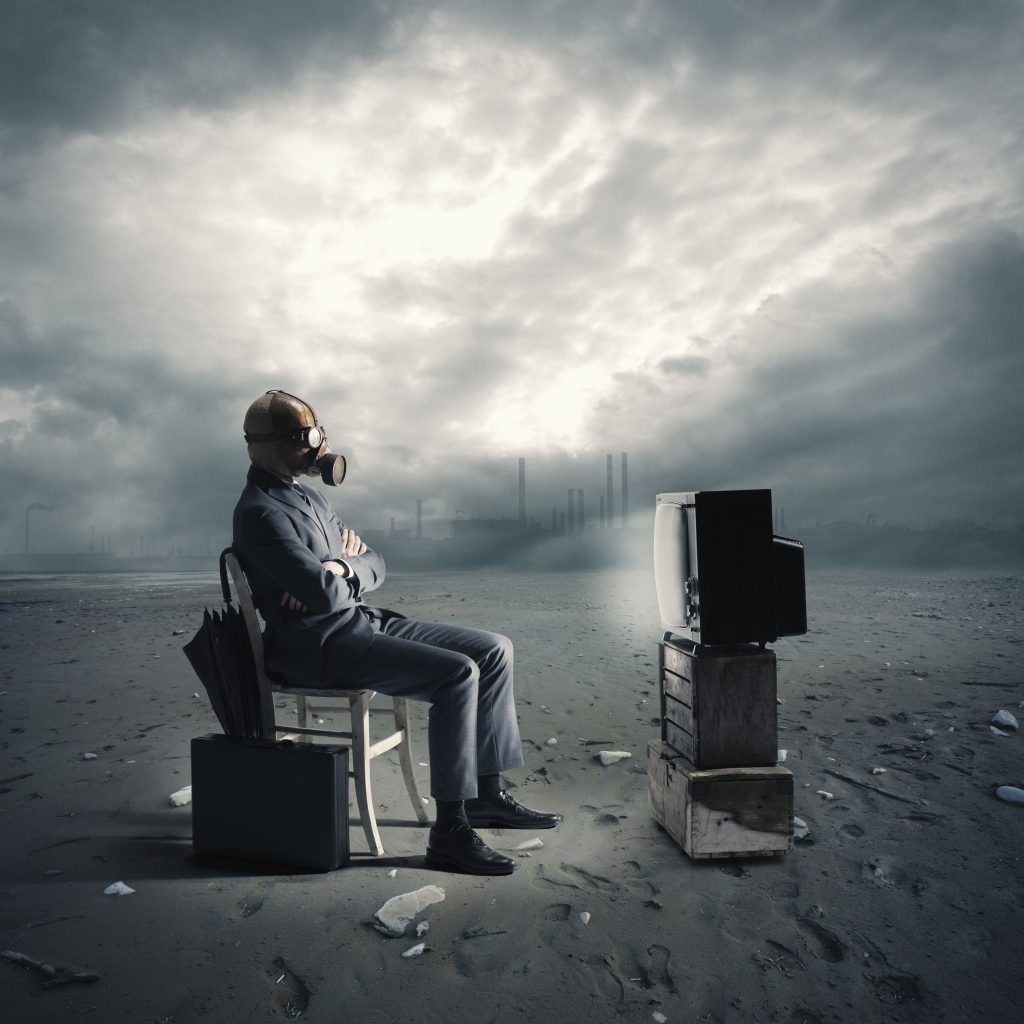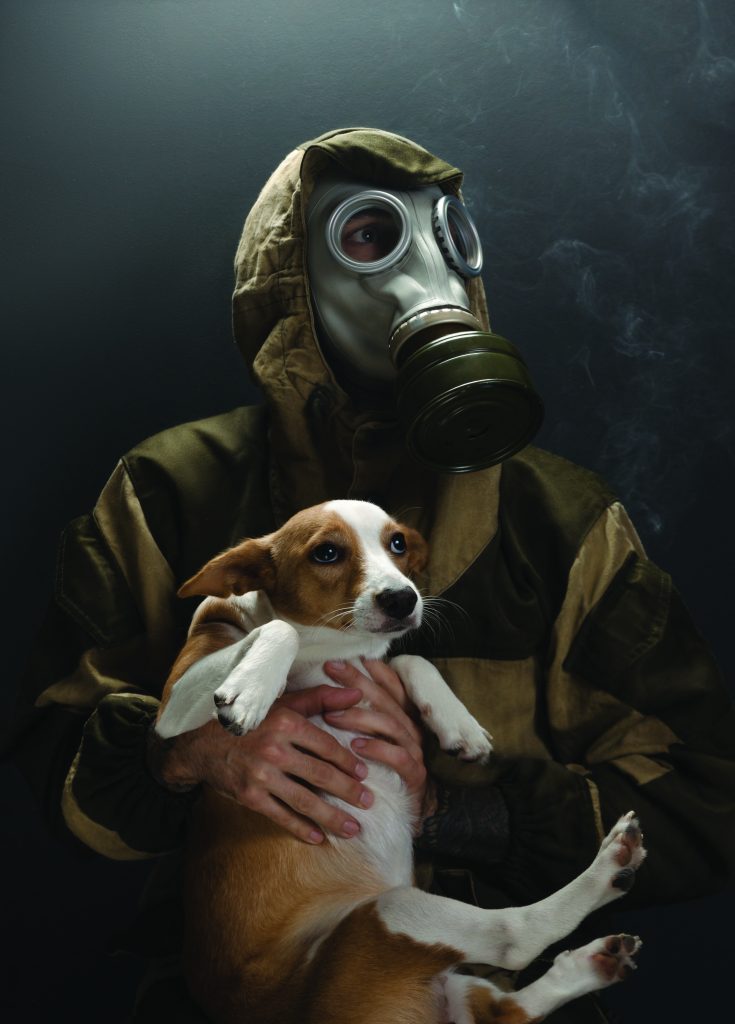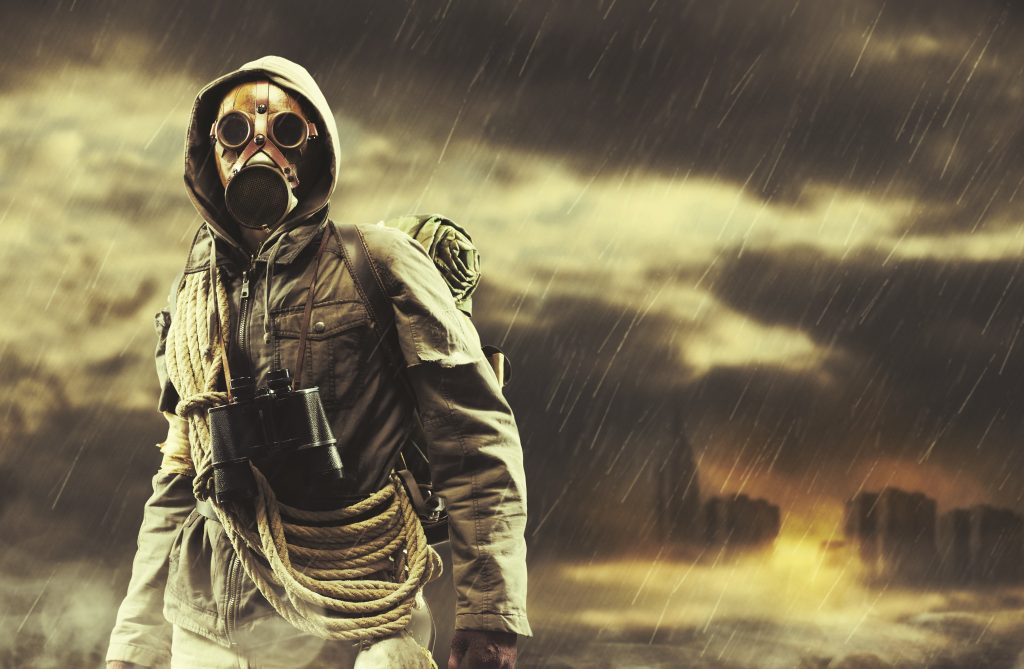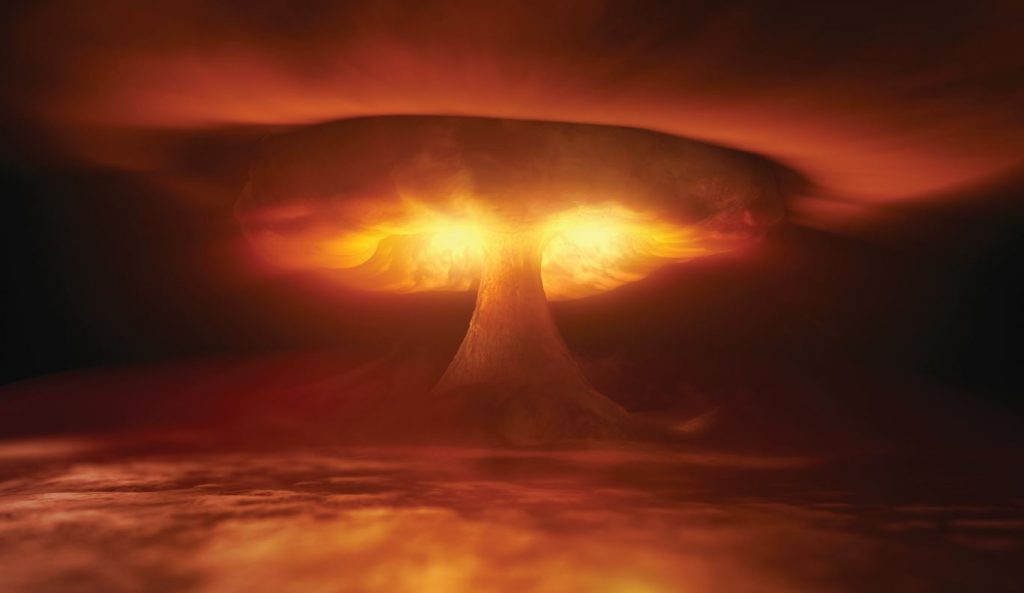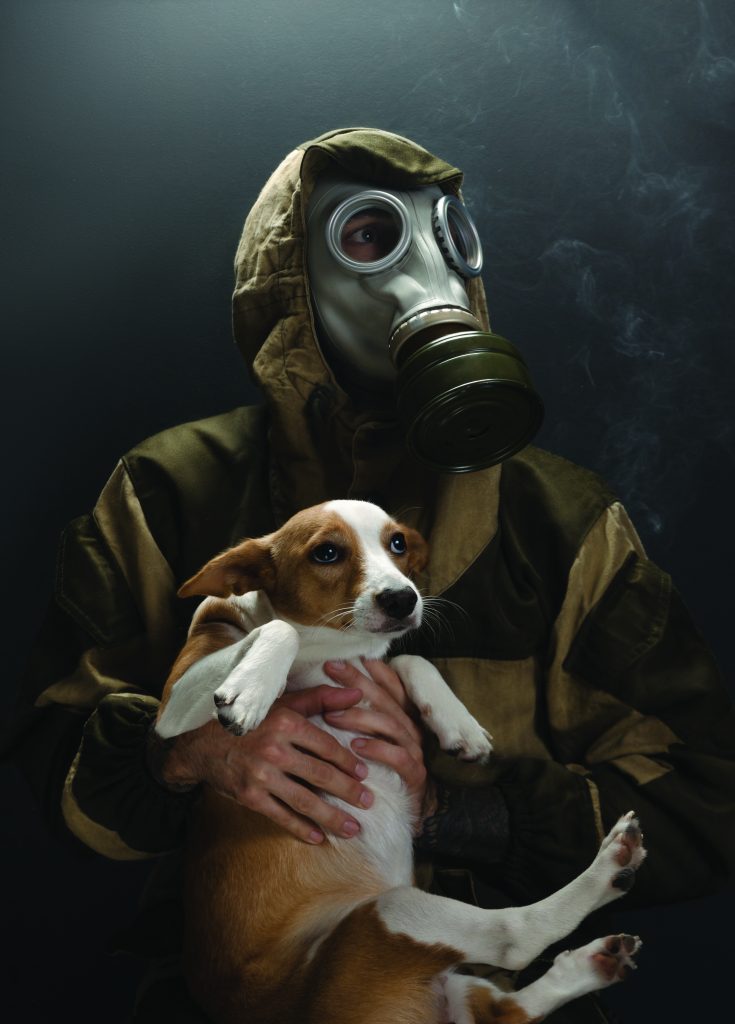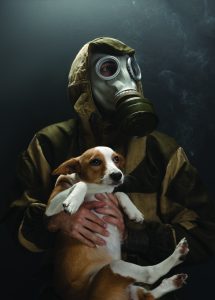Let’s face it: We live in uncertain times.
Seas are rising. The climate is changing. Nuclear-armed countries are escalating their rhetoric, with our own president making threats of nuclear strikes. Increased dependence on automation is making us ever more vulnerable to a robot uprising. Scientists tinkering with “superbugs” and years of antibacterial soap use could lead to a disease outbreak. And on top of all that is the ever-present threat that aliens or zombies could come along and wipe us out.
We at the Advocate want you to be ready. We’ve watched the movies. We’ve read the books. And we know the area. You want to survive the coming end of days? Your best bet is to commit the following guide to memory!
We’ve organized our helpful survival guide into sections on how to secure food and water, find shelter, gather the tools and/or weapons you might need, to maintain your health, and find others like you who can help you survive. Since we don’t know which of the many possible end-of-days scenarios we’ll be hit with (though my money is on robots) we’ve tailored specific advice to get you ready for anything with the following helpful and fun apocalypse-themed stickers:
So read on, hopeful armageddon survivor! Prepare yourself for the coming calamity and if you’re one of the lucky ones to make it through and help rebuild society from the ground up, don’t forget the immortal words from the utopian future of Bill & Ted: “Be Excellent to Each Other” and “Party on, Dudes!”
—Dave Eisenstadter
FOOD AND WATER
By Meg Bantle
Water is the first thing you need to secure in the event of a disaster or apocalypse. Humans can only survive three days without water (compared to three weeks without food). Keeping a stash of bottled water and water filters in your home is a good place to start, that way you have enough water for a few days without even having to think about it. Cooking and boiling water without electricity is another important thing to consider. Keeping a camping stove and extra fuel with some canned and high protein dried goods is a good foundation for surviving whatever level of hell these apocalypses unleash.
 Zombies: When picking out a location, water is the most important thing to consider. If you’re bunkering in Night of the Living Dead style, make sure you have running water or bottled water on hand. If you are going to take a more nomadic approach like in The Walking Dead, you should grab a map and plan routes along bodies of freshwater instead of along roadways. The Quabbin is a huge source of water, but as the largest freshwater body in Massachusetts it’s likely to be a hotspot for people (and thus zombies). Following the Connecticut River up to Canada might be your best bet. If you are depending on freshwater, be sure to bring a water filter. You can buy them at most camping gear stores, including Eastern Mountain Sports in Hadley and Sam’s Outdoor Outfitters in Hadley and Brattleboro.
Zombies: When picking out a location, water is the most important thing to consider. If you’re bunkering in Night of the Living Dead style, make sure you have running water or bottled water on hand. If you are going to take a more nomadic approach like in The Walking Dead, you should grab a map and plan routes along bodies of freshwater instead of along roadways. The Quabbin is a huge source of water, but as the largest freshwater body in Massachusetts it’s likely to be a hotspot for people (and thus zombies). Following the Connecticut River up to Canada might be your best bet. If you are depending on freshwater, be sure to bring a water filter. You can buy them at most camping gear stores, including Eastern Mountain Sports in Hadley and Sam’s Outdoor Outfitters in Hadley and Brattleboro.
If you’re seeking shelter in a house or structure, make sure you have a way to cook without electricity. Everything will be in chaos post-outbreak so I wouldn’t depend on your utilities. Dried goods like rice and beans are great resources as are canned goods. Farms like Crimson and Clover in Northampton or Red Fire Farm in Granby might be a good bet, but you will probably have other people to contend with at those locations. If you have enough supplies to last awhile, learn a lesson from the folks in the 2004 Dawn of the Dead remake and DON’T LEAVE THE SHELTER (why would you?) If you do decide to go on the move because you’re looking for survivors (see I Am Legend) you might want to grab an edible wild plants guide from Broadside Books in Northampton. You could also learn how to eat acorns and squirrels! Take a class at the Earthwork Wilderness Survival Training School in Northampton to learn how to build fires and track animals.
 Nuclear: If a 10 kiloton nuclear bomb was dropped (the size that North Korea tested in 2013) in New York City (sorry Manhattan) almost everyone within one mile would die immediately. People within 1.5 miles would experience third degree burns due to heat. If you are within 10 to 20 miles of the detonation, you are at risk of nuclear fallout. The rule of thumb to tell if you are in the fallout zone is literally a rule of thumb: if you hold your thumb up and the mushroom cloud is bigger than your thumb then you are at risk. In that case, finding water might be difficult because exposed freshwater sources will be contaminated with radiation. You should only drink bottled water or water from an underground well, which are most commonly found in rural areas.
Nuclear: If a 10 kiloton nuclear bomb was dropped (the size that North Korea tested in 2013) in New York City (sorry Manhattan) almost everyone within one mile would die immediately. People within 1.5 miles would experience third degree burns due to heat. If you are within 10 to 20 miles of the detonation, you are at risk of nuclear fallout. The rule of thumb to tell if you are in the fallout zone is literally a rule of thumb: if you hold your thumb up and the mushroom cloud is bigger than your thumb then you are at risk. In that case, finding water might be difficult because exposed freshwater sources will be contaminated with radiation. You should only drink bottled water or water from an underground well, which are most commonly found in rural areas.

The rule of thumb to tell if you are in the fallout zone is literally a rule of thumb: if you hold your thumb up and the mushroom cloud is bigger than your thumb then you are at risk.
If you don’t live in the fallout zone, the most threatening aspect of nuclear war is the prospect of a nuclear winter. Nuclear winter is the global cooling effect hypothesized to occur after the firestorms that follow a nuclear detonation. A firestorm (a more terrifying version of Sharknado) can occur after a nuclear explosion when gale-force winds and large scale fires combine and shoot soot and ash into the atmosphere. The fear is that this soot could stay in the atmosphere for several years, blocking the sun and cooling the earth. In these conditions, it would be impossible to grow food except for natural-gas-digesting bacteria and mushrooms. Mycoterra Farms in Deerfield and Fungi Ally in Hadley both sell mushroom grow kits.
 Climate Change: Abrupt climate change, as seen in The Day After Tomorrow, is not a realistic depiction of how global warming is going to affect things. That said, Americans are already seeing the impacts of climate change with more severe droughts, wildfires, and hurricanes. Here in the Pioneer Valley we are far from safe. Global warming is likely going to result in more extreme precipitation, meaning more intense precipitation events that last longer but occur less frequently, leading to more flooding and more droughts. This trend is already apparent in the Northeast where the amount of precipitation falling in heavy precipitation events increased by 71 percent between 1958 and 2012.
Climate Change: Abrupt climate change, as seen in The Day After Tomorrow, is not a realistic depiction of how global warming is going to affect things. That said, Americans are already seeing the impacts of climate change with more severe droughts, wildfires, and hurricanes. Here in the Pioneer Valley we are far from safe. Global warming is likely going to result in more extreme precipitation, meaning more intense precipitation events that last longer but occur less frequently, leading to more flooding and more droughts. This trend is already apparent in the Northeast where the amount of precipitation falling in heavy precipitation events increased by 71 percent between 1958 and 2012.
Even if rainy winters are on the horizon for Bay Staters, knowing how to be prepared for a blizzard or ice storm is still important. If you’re in your house, remember that blizzards and ice storms often cause electricity outages. If you have an electric stove, you should make sure to have an alternative way to cook. Ready.gov warns that you should be cautious when using an alternative heating or cooking source and have functioning fire extinguishers and carbon monoxide alarms. If you have enough time, heading to the grocery store to buy extra food isn’t a bad idea (that said keep calm people, there’s no need to panic at Big Y). You may need to shut off the pipes in your house if you are worried about them freezing. If so make sure you have water stored elsewhere to last through the storm, either in bottles or in bathtubs that you fill before shutting off your water valve.
 Asteroids and comets: Just before the turn of the millennium, everyone was freaking out about the world ending in all sorts of ways. One major theme that came out of Hollywood was the fear that a giant comet or asteroid was going to hit the Earth (Deep Impact/ Armageddon). As it turns out, it’s very unlikely that an extinction-level asteroid is going to hit Earth in the next century because NASA knows the paths of over 90 percent of near-Earth asteroids that are over 1 km (0.6 mi). Despite this, smaller asteroids are still very dangerous and researchers from NASA report that we are currently unprepared to deal with an incoming asteroid.
Asteroids and comets: Just before the turn of the millennium, everyone was freaking out about the world ending in all sorts of ways. One major theme that came out of Hollywood was the fear that a giant comet or asteroid was going to hit the Earth (Deep Impact/ Armageddon). As it turns out, it’s very unlikely that an extinction-level asteroid is going to hit Earth in the next century because NASA knows the paths of over 90 percent of near-Earth asteroids that are over 1 km (0.6 mi). Despite this, smaller asteroids are still very dangerous and researchers from NASA report that we are currently unprepared to deal with an incoming asteroid.
Let’s say real-life Bruce Willis doesn’t step up to the plate (though I wouldn’t put it past him): what happens if a “small” asteroid (smaller than 1 km across) hits Earth? In the early 19th century in Central Russia, an asteroid that is calculated to have been 100-meters across exploded above the ground devastating the landscape. The explosion leveled an area the size of all of Hampden County and some of Hampshire County. Basically, if we are the target of an asteroid, head for the hills. There will be nothing to return to after impact so use whatever notice you get from NASA to pack up all of your belongings and find a new place to settle down.
If an asteroid does careen towards Earth, there’s a good chance it would land in an ocean, not on land, which could cause a tsunami. Even if people were evacuated from tsunami zones, the damage caused to agriculture and water sources after a tsunami would be huge. Entire coastlines could be turned to waste. Between this and the refugee crisis that is likely to follow widespread evacuation zones, food and water resources might become scarce. Find somewhere to live where you can grow your own food, ideally somewhere near fresh water or with a private well. Reverting to growing your own food is a great way to ensure that you can survive and feed others around you.
SHELTER
By Chris Goudreau
So, you’re looking for shelter in the end of the world. Whether you have to contend with killer robots, extraterrestrials hell bent on conquering the planet, or flesh eating zombies on the hunt, you’re going to need to somewhere safe to lay down your burdens. The apocalypse is the definition of stress, so having a place to call home (with nifty defenses and traps) should be able to ease your mind at least a little bit.
Nuclear: If you’re one of the lucky ones and wasn’t in the blast zone of a hydrogen bomb, you’re probably going to be looking for shelter from the radioactive fallout that will be sweeping through the area as nuclear winter sets in. In the event of a large scale nuclear war, eastern Massachusetts and the greater Boston area would be the main target, according to retro FEMA preparation maps from the 1990s. However, there would likely be at least one or two nukes sent to Hampden and Hampshire counties that would target cities such as Springfield and Northampton. Your best bet for shelter, if you aren’t in the blast zone, is to find a bomb shelter. However, actually finding an active fallout shelter may prove difficult. There are no listings on the internet that catalogs addresses to find shelter against nukes in Western Mass. That should be disturbing. People in the fallout zone will need to get far underground (think mineshafts in Dr. Strangelove). There’s an abandoned Davis Pyrite Mine in Rowe that could be safe, or two stories beneath tall concrete buildings like Tower Square and Monarch Place in Springfield. Even being indoors or in a basement could save your life from deadly radiation.
Aliens: In the event of extraterrestrials invading our tiny speck of dirt in the cosmos that we call planet Earth, you might just want to run and don’t look back. Any civilization that can voyage through the vastness of space and has achieved faster-than-light travel is centuries if not eons more advanced than our species. Simply put, it would be like an ant trying to find shelter against a bulldozer. As science fiction author Douglas Adams described in his novel, “The Hitchhiker’s Guide to the Galaxy,” it might be better to just enjoy good tidings of peanuts and beer or put a paper bag over your head. Whether it’s your Lovecraftian nightmare Cthulhu creature from a distant galaxy or little green men from outer space, “lie back and let the planet dissolve around you,” in the words of hyper intelligent singing dolphins from the film adaptation of Douglas’ novel. So, go hang out at New City Brewery or Northampton Brewery for a relaxing apocalypse. If you happen to be a doom-prepper though, you’ll probably last the longest in the event of an alien invasion. A nice little holed up hideaway complete with food, water, and supplies is the only ideal place to be somewhat safeguarded by extraterrestrials.
Zombies: As a rule, the undead aren’t that smart. They’re mostly like your average drive-thru fast food customer, but all corpsified and willing to actually crawl out of their vehicles for a meal. The inherent problem with zombies is obviously their sheer numbers. If 80 to 90 percent of a population has joined the legion of the undead and you’re not smart about taking shelter, you’ll probably enter into their ranks. The general rule of thumb would be to avoid cities like the plague because that’s the most likely place where you’ll encounter unexpected peek-a-boo zombies on your hunt to score precious resource loot. Any sparsely populated area is a wise choice to create your shelter. Some of the hilltowns in Franklin and Hampshire counties as well as the Berkshires would be ideal locations compared with moderately populated cities such as Northampton or Amherst. Consider Ashfield or Cummington; Sheffield or Orange. However, you’ll need more than just a simple country abode to keep you in the land of the living. Fortify your shelter with defenses, whether that’s barbed wire, wooden or steel blockades complete with sharp pointed sticks, a moat and a drawbridge, or Home Alone-esque traps.
AI/ Robots: If robots or artificial intelligence driven machines decide to take over the world, humanity would be in a serious pickle to say the least. With Terminators in the street or killer robots on the prowl, what’s a simple homo sapien to do? Hide, of course. The ideal location for hiding from genocidal machines would be an abandoned missile silo or bunker with filtered air systems. Any machine with half a brain would utilize biological weapons in its pursuit to eradicate human life off the face of the planet. It’s the perfect weapon for a machine because it doesn’t impact them in the slightest. If for some reason a possible robot rebellion decides to go another route, such as nuclear weapons, please read our section about finding shelter against a nuclear war. If the only threat you’d have to face is relentless machines with weapons on the hunt for humans, you’re best bet is to stay in small groups traveling discreetly. Using any type of automobile would be a dead giveaway. One of the best cases for shelter in this scenario would be building your own structure in the middle of the wilderness, such as the Arcadia Wildlife Sanctuary, and hope for the best. However, robots would most likely be methodical, so it would only be a matter of time before they stumbled upon your hideaway.
Disease: Pestilence has been around as long as life itself. Humanity knows a thing or two about surviving against plagues. The general rule with a lethal disease outbreak would be making sure you wouldn’t come into contact with anyone infected with it. That means having a small group of six to 12 people would be ideal. You wouldn’t want to live in cities with high populations such as Springfield. Unless there’s a vaccine or a cure for such a pathogen, you probably won’t want to visit any hospitals. You’d want to find a location with enough land to support your group such as near the Quabbin Reservoir. Disease is the most comfortable end of the world scenario, however, because the threat is only microscopic and you wouldn’t have to worry about suddenly being attacked by a zombie, robot, or alien. That’s the bright side at least.
HEALTH AND MEDICINE
By Meg Bantle and Chris Goudreau
After a global disaster or apocalypse, medicines will eventually be some of the highest valued products. It might not be the first thing you think of, but if someone gets hurt or infected you don’t want to be scrambling for the medications you need. Don’t be like Jake Gyllenhaal’s character in The Day After Tomorrow and wait until the last minute to gather medical supplies. Keep at least a basic first aid kit in your car and house. There is also a good chance that any apocalypse is going to force millions of people to be on the move. If you’ve been putting off that exercise routine, what better motivation is there than survival?
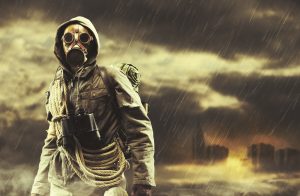
Whether it’s an Invasion of the Body Snatchers or Mars Attacks! doomsday alien invasion, you want to make sure that your health, both mental and physical, are in tip-top shape.
Zombies: If a zombie outbreak happens there’s a good chance that you won’t have much time to train. Ideally, you will heed the advice of this article and prepare your body for an outbreak in advance. Back in the sixties, zombies were slow. The walking dead in Night of the Living Dead do just that: walk. But since Danny Boyle’s 28 Days Later in 2002 and the Dawn of the Dead Remake in 2004, zombies can flat out sprint (horror movie buffs who want to argue about whether infected people are legitimate zombies or not can take that up in the comments section). The best way to train for these new sprinting zombies is to do interval training. You can’t outrun the undead over long periods of time, but you can out-sprint them to get to safety. Another useful skill would be parkour. If you’re in a cityscape like Atlanta in The Walking Dead, zombies will probably not chase you along a straight line. Knowing how to safely jump and roll could be a game changer. At Hampshire Gymnastics School in Amherst you can take parkour classes to learn the basics. Remember, you don’t need to outrun the zombies, you only need to outrun the person you’re with!
Nuclear: Staying healthy in a nuclear apocalypse is a troubling endeavor to say the least. Nuclear fallout is the biggest danger, which could contaminate food and water sources hundreds of miles away from the blast zone. Anti-radiation pills, aka potassium iodide, will likely be your best friend (or your dog will) while you’re out scavenging supplies in the irradiated hell hole that used to be downtown Northampton. Any other cut, bruise, or illness that you sustain in daily survival would be compounded by the fact that nutritional foods are most likely a rare commodity and any medicine you come across from bandages to aspirin would be handy. However, radiation sickness and cancer would be the biggest worries to one’s health, it would be a miracle for your health to remain unscathed after nuclear armageddon. In that respect, maybe you’d be better off being vaporized in the blast zone than slowly having your insides roasted by radiation?
Aliens: Whether it’s an Invasion of the Body Snatchers or Mars Attacks! doomsday alien invasion, you want to make sure that your health, both mental and physical, are in tip-top shape. If you’re dealing with a god-like cosmic Lovecraftian horror ala Cthulhu, you might want to avoid staring at these type of extraterrestrial beings because in all likelihood our feeble human minds would snap like a twig into endless dark pits of insanity. With your standard variety of Star Trek-esque aliens, any form of medicinal care would do. Directed energy weapons can cause intense burns, so remember that pain killers, bandages, disinfectant, and aloe are important tools on the road to a healthier you. If it’s aliens that feast on the flesh of human beings, your best bet is to start an active cardio routine to escape your would be predators.
Asteroid: Even if it’s a life killing asteroid that’s headed to Earth, you likely still want to maintain adequate health even in the most dire circumstances. If the asteroid landed in an ocean, expect enormous island swallowing tsunamis along the coast. If the asteroid, meteorite, or comet hits on land, expect a scenario closer to a nuclear winter, with crops being impacted after the sun is blocked out by dust and debris. Gas masks would be an important resource to make sure you don’t breathe in any earthy material churned up into the atmosphere. In addition, any medical supplies you come across would be invaluable in this new post apocalyptic world such as medication, bandages, disinfectant, and pain killers.
WEAPONS AND TOOLS
By Chris Goudreau
The apocalypse has arrived and now you need all the weapons for defense and tools to survive that you can gather. Whether that’s being able to breathe by using a gas mask or putting a shotgun right between the eyes of a hungry zombie, you’ll need more than your wits to survive.
Aliens: If aliens invaded our planet how would you defend against that cosmic threat? There are billions, if not trillions of stars across the millions of galaxies in our observable universe and there’s a good chance that at least a decent amount of them would support life, if not intelligent life. For all we know our atmosphere could be toxic to a species invading Earth or as in the horrible M. Night Shyamalan film, Signs, water would be lethal to a space-faring species from another planet. There are so many variables and knowledge about the extraterrestrial would be your best weapon and tool. Some actual handy dandy tools and weapons that you might want to have on you would likely include a Swiss Army knife for opening a can of beans (or a can of whoop ass), a flashlight, a projectile weapon such as a gun or a crossbow, and of course, duct tape. You never know when you might need duct tape.
Zombies: Festering walking corpses aren’t too much of hassle in small numbers, but things get dicey when it comes to massive hordes of the undead. You’ll likely want some kind of blunt or sharp weapon such as a shovel or a sword to either bash or slash your zombie opponent into oblivion. If Night of the Living Dead or the plethora of other zombie films, video games, or TV shows have taught us anything, it’s to aim for the head. A projectile weapon is ideal too because it lowers the threat of being bitten by one of the ghoulish creatures. Although a sawed-off shotgun is tempting to use because of its boomstick connotations, you might be better off with the stealthier crossbow option. Plus, as Daryl Dixon from AMC’s The Walking Dead has shown us, you can re-use crossbow bolts, which makes it a more practical weapon if you need to conserve your ammo. For tools, you’d want to have good shoes for all the running you’d be doing to escape zombie hordes, especially if you’re facing the modern running zombies of 28 Days Later. A water purifier is an essential item as well as a flashlight, and homemade noise traps such as a fire alarm attached to a firecracker. That tool would be best for distracting zombies while either leaving the area for safer zones or searching for valuable resources.
AI/ Robots: The best weapon to use against a robot would be an electromagnetic pulse (EMP) that would likely shut off any attacking homicidal machine. However, using that type of weaponry is impractical and downright absurd if you’re in survival mode due to the fact that it takes a lot of energy to generate an electromagnetic pulse. For instance, nuclear weapons generate EMPs, so unless you have a hidden nuke in your pocket, this wouldn’t be a good option. Your other, more practical weapons, would include guns with armor piercing rounds or explosives. In the event of a robotic uprising, you’d likely want to have a good energy drink handy because robots don’t sleep. Other tools you’d want to have in your arsenal would include a flashlight, gas mask, water filter, Swiss Army knife, lock pick, or a book of jokes (robots are well known for not having a sense of humor and you might just get a ‘does not compute’ malfunction).
Nuclear: It’s not weapons that you’d likely need if nuclear armageddon arrived, you’d want to stock up on as many tools as you could carry. Those would include medicine, bandages, flashlights, gas masks, canned food, potable water, potassium iodide pills for anti-radiation, and the list goes on. Radioactive material would be your biggest enemy. It would be in the food and drinking water. Crops would die off in record numbers and the sun would be blocked by a nuclear winter. Greenhouse equipment would be ideal if you decided to grow your own food. In addition, you’d want to stock up on lead paint to help shield any shelter you have from some of the radiation as well as bottle caps because they very well might be the future currency in this new fallout plagued world. Better start stocking up at Provisions in Northampton.
Climate change: The thing about climate change is it’s already happening, but the climate change apocalypse that we’ll be discussing is centered on a world in which the seas have risen to such an extent that cities such as Boston and New York are underwater or mostly submerged. You’d likely need all the tools for survival as you would in any other apocalyptic scenario, but the biggest threat you would face would be other humans. An arsenal of projectile weapons as well as sharp or blunt weapons should deter any would be assailant or thief. But the inherent problem with surviving in a hotter climate would be utilizing existing infrastructure, which would be in shambles because (surprise!) they were built with a 20th century climate in mind. High ground is your friend and areas away from the coast would be better locations to survive in. Items that you’d want to have handy include, water purifiers, canned foods, knives, bug repellent, tents, vitamins, The Grapes of Wrath by John Steinbeck, and really just anything you can think of to either pass the time or utilize for survival.
COMPANIONSHIP
By Dave Eisenstadter
Where did it all go wrong? Could we have stopped it if we tried a little harder? These introspective questions will be plaguing all of the remains of humanity following any society-ending disaster. For some, the vulnerability and self-searching will lead to a greater willingness to tolerate their fellow survivors and form friendships where before antipathy might have reigned. For others, bitterness over the mistakes of humankind might lead them to seek revenge on anyone left. Finding the right companions is essential to rebuild society, and — who knows — the post-apocalyptic utopia you create could prevent humankind from ever facing such world-ending calamity again.
Disease: This one is tricky, because fellow humans might be carriers of the horrific disease and coming into contact with anyone might pass it on to you. The solution: find a pet. Often disease bacteria and viruses only affect certain types of organisms. For instance, while the Ebola virus killed more than 11,000 people in Guinea, Sierra Leone, and Liberia during an outbreak in 2014, there were no reports of dogs or cats getting sick with the disease. Head on over to the Dakin Humane Society in Leverett or Springfield and get a leg up on finding your post-apocalyptic best friend.
Perhaps you, like the survivors in Stephen King’s The Stand, happen to be one of the lucky ones who is immune to the disease. There will be so few people left that it might be hard to find one another, so let’s pick a meeting spot now. I nominate Turner’s Falls — lots of great river frontage, a bit of distance from the main roads where roving bands of miscreants can cause havoc, a charming downtown with nice public art, a bar actually called The Rendezvous, and — for once we get things up and running again — an airport!
Nuclear: Even if Western Mass is spared a direct hit from a nuclear missile, the going will still be rough due to the soot from firestorms across the world blocking out sunlight and creating the global cooling effect known as nuclear winter. We’ll need many hands on deck to do hard work, building fires to stay warm, shelters from the nuclear fallout, and coming up with ways to maintain the food and water supply. That means no finger-pointing over who’s fault those missile launches were. If the person you’ve been assigned to share a two-person sleeping bag to survive the night voted for Trump, let it slide. If you learn that someone in your fallout shelter happened to be a Russian or North Korean spy before the blasts, let bygones be bygones. In preparation for what may be some difficult forgiveness exercises, take a moment now to visit the Peace Pogoda in Leverett or the ShaoLin Meditation Temple in Springfield. Make an appointment at one of the region’s meditation centers, like Valley Mindfulness in Florence, Pioneer Valley Shambhala in Northampton, or Dhamma Dhara Vipassana Meditation Center in Shelburne Falls.
Zombies: When facing the ravenous hordes of the walking dead, you’re going to need a buddy or two to watch your back, take shifts as lookout while you sleep, and maybe even to save your life with a dramatic, well-timed head strike at a zombie who somehow got too close and was about to bite! With roads cut off, power lines down, and cell phone networks a thing of the past, your best bet might be your own next door neighbors. So make a point right now to unglue your eyeballs from your smartphone and hold a block party! Those games of corn hole and horseshoes could wind up being practice for hurling javelins at zombie legions. And, hey, in the slim chance that the world isn’t going to be consumed by zombies, you might just make some new friends.
Aliens/Robots: The problem with both aliens and robots (as we’ve learned from Invasion of the Body Snatchers, Alien, Blade Runner, Men in Black, Battlestar Galactica), is that they can sometimes appear just like humans. This creates two problems: you can’t trust others and others can’t trust you. So how to organize and fight back? Luckily, we in the Pioneer Valley have an excellent tool at our disposal. If you ask someone whether “West Mass” is an acceptable name for this region, and they say yes, they are an alien and/or robot and must be terminated.
Climate change: In the all-too-real scenario that climate change will drastically alter our world, one of the likely outcomes is an increase in refugee crises. But if we’re going to create a livable world out of the embers of the old together, we need to work with one another and see the similarities, not the differences between us. Volunteer with the Pioneer Valley Workers Center, and meet real migrants working in the area. Enroll in language classes at the International Language Institute of Massachusetts or Greenfield Community College to help you communicate with people from across the world. If the result from an apocalyptic end-of-world scenario is that we learn to respect one another for our differences, will it all be worth it? Um, no. But it would be a nice consolation prize to enjoy while we’re sailing on the open ocean searching for land.
Dave Eisenstadter can be reached at deisen@valleyadvocate.com. Chris Goudreau can be reached at cgoudreau@valleyadvocate.com. Meg Bantle can be reached at mbantle@valleyadvocate.com.


